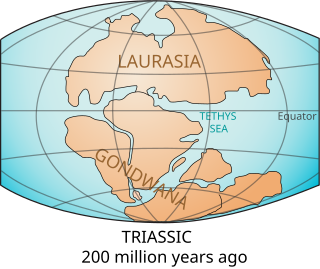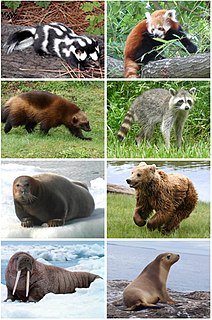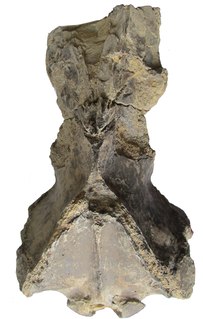
The Tethys Ocean, also called the Tethys Sea or the Neo-Tethys, was an ocean during much of the Mesozoic Era located between the ancient continents of Gondwana and Laurasia, before the opening of the Indian and Atlantic oceans during the Cretaceous Period.

The Pannonian Sea was a shallow ancient sea, where the Pannonian Basin in Central Europe is now. The Pannonian Sea existed during the Miocene and Pliocene epochs, when a 3–4 km (1.9–2.5 mi) depth of marine sediments were deposited in the Pannonian Basin.
The Langhian is, in the ICS geologic timescale, an age or stage in the middle Miocene epoch/series. It spans the time between 15.97 ± 0.05 Ma and 13.65 ± 0.05 Ma during the Middle Miocene.

The Paratethys ocean, Paratethys sea or just Paratethys was a large shallow inland sea that stretched from the region north of the Alps over Central Europe to the Aral Sea in Central Asia. The sea was formed during the Oxfordian stage of the Late Jurassic as an extension of the rift that formed the Central Atlantic Ocean and was isolated during the Oligocene epoch. It was separated from the Tethys Ocean to the south by the formation of the Alps, Carpathians, Dinarides, Taurus and Elburz mountains. During its long existence the Paratethys was at times reconnected with the Tethys or its successors, the Mediterranean Sea or Indian Ocean. From the Pliocene epoch onward, the Paratethys became progressively shallower. Today's Black Sea, Caspian Sea, Aral Sea, Lake Urmia, Namak Lake and others are remnants of the Paratethys Sea.

Phocinae is a subfamily of Phocidae whose distribution is found in the seas surrounding the Holarctic, with the Baikal seal being the world's only freshwater species of pinniped. What distinguishes them from other phocid seals is the presence of well-developed claws on their front and back flippers. The Phocinae is divided into three extant tribes: Erignathini, Cystophorini, and Phocini. Members of both Erignathini and Cystophorini have 34 chromosomes, while species in the tribe Phocini have 32 chromosomes.

Arctoidea is an infraorder of mostly carnivorous mammals which include the extinct Hemicyonidae (dog-bears), and the extant Musteloidea, Pinnipedia, and Ursidae (bears), found in all continents from the Eocene, 46 million years ago, to the present. Arctoids are caniforms, along with dogs (canids) and extinct bear dogs (Amphicyonidae). The earliest caniforms were superficially similar to martens, which are tree-dwelling mustelids. Together with feliforms, caniforms comprise the order Carnivora, sometimes Arctoidea can be considered a separate suborder from Caniformia and a sister taxon to Feliformia.
Leptophoca is an extinct genus of earless seals from the North Atlantic realm.
This article records new taxa of fossil mammals of every kind that have been described during the year 2013, as well as other significant discoveries and events related to paleontology of mammals that occurred in the year 2013.

Pliophoca is an extinct genus of seal in the family Phocidae.
Eomellivora is an extinct genus of prehistoric mustelid closely related to the honey badger known from the Eurasia and North America, and tentatively Africa.
Nanophoca is an extinct genus of earless seals from the middle Miocene of Belgium.
Phocanella is an extinct genus of earless seals from the early Pliocene of Belgium and the US Eastern Seaboard.
Pachyphoca is an extinct genus of earless seals from Neogene marine deposits in the northern part of the Paratethys basin.
Platyphoca is an extinct genus of earless seals from Neogene marine deposits in the North Sea basin.
Gryphoca is an extinct genus of earless seals from Neogene marine deposits in the North Sea basin.
Praepusa is an extinct genus of earless seals from Neogene marine deposits in Europe.
Afrophoca is an extinct genus of earless seal from Miocene-age marine deposits in Libya.
Auroraphoca is an extinct genus of earless seals from the early Pliocene of what is now the U.S. Eastern Seaboard.

Ciuciulea is a genus of cetotheriid mysticete found in middle Miocene marine deposits in Moldova.
Prototaria is an extinct genus of pinniped that lived approximately 15.97 to 13.65 mya during the Middle Miocene in what is now Japan. It belonged to the family Odobenidae, the only extant species of which is the walrus. Members of the genus Prototaria are believed to be the most basal imagotariine pinnipeds.










